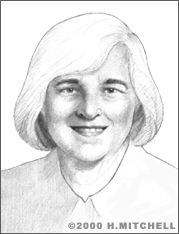Isabella Karle
Isabella Karle is a true pioneer of physical chemistry, who invented new methods, using first electron and then x-ray diffraction to study the structure of molecules.
Karle was quite a precocious child, whose love of science had translated into a BS (1941), MS (1942), and PhD (1944) in physical chemistry from the University of Michigan before her 23rd birthday. While at Michigan, she married her fellow chemistry graduate student Jerome Karle. The couple worked briefly on the Manhattan Project at the University of Chicago (1943), before returning to Ann Arbor, where Isabella became the first female member of the chemistry faculty. In 1946, they transferred together to the Naval Research Laboratory (NRL) in Washington, D.C.
Jerome Karle used complex mathematics to develop "direct methods" for analyzing the structure of crystals – work that would later win him the Nobel Prize in chemistry (1985). Isabella Karle began working in chemical analysis by electron diffraction and invented a superior apparatus to perform the process. She also taught herself x-ray crystallography from textbooks so that she could invent practical applications for her husband's theories, which were received with some skepticism. In 1963, she published her "Symbolic Addition Procedure," which used x-ray analysis to determine essentially equal-atom crystal and molecular structures.
When scientists bombard a crystal with x-rays, the beam scatters, or "diffracts," in a pattern determined by the distances and angles between its atoms. The method works reliably only if the x-rays' wavelength and the intervals between atoms are about the same. Isabella Karle's improved process vindicated her husband's direct method theory, drastically improved the speed and accuracy of chemical and biomedical analysis, and remains the basis of all advanced x-ray crystallography, including computerized programs, used around the world today. Thanks to Karle's process, the number of new molecular analyses published annually skyrocketed from about 150 to over 10,000.
By an equally revolutionary three-dimensional modeling process, Karle identified and elucidated the structures of hundreds of important molecules. She was the first to publish the structure of many complex organic and inorganic substances, including steroids, alkaloids, toxins, ionophores, and especially peptides (amino acid compounds). With a pattern of these molecules' structure in front of them, researchers in organic and synthetic chemistry are able to move forward with much greater speed and confidence.
Isabella Karle served at NRL as Chief Scientist of its X-ray Diffraction Section until she retired in 2009 with her husband, Jerome Karle, Chief Scientist of its Structure of Matter Lab. Although she did not share her husband's Nobel Prize, Karle did receive the Swedish Royal Academy of Sciences' Aminoff Prize in 1988. Her other honors include Women in Science and Engineering's Lifetime Achievement Award (1986), the Franklin Institute's Bower Award (1993), and the National Medal of Science (1995). She was also elected as a fellow of the American Academy of Arts and Sciences in 1993.


